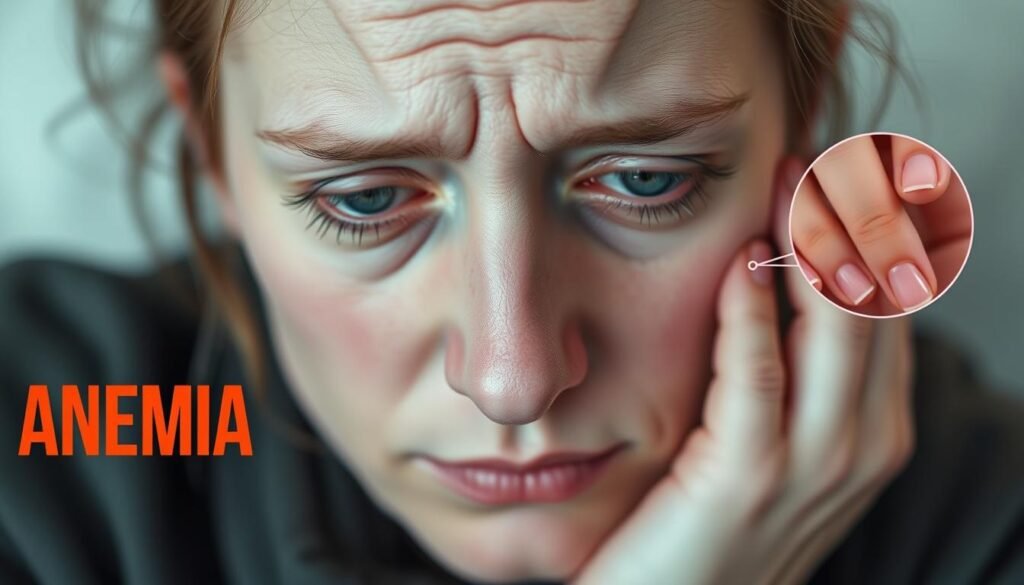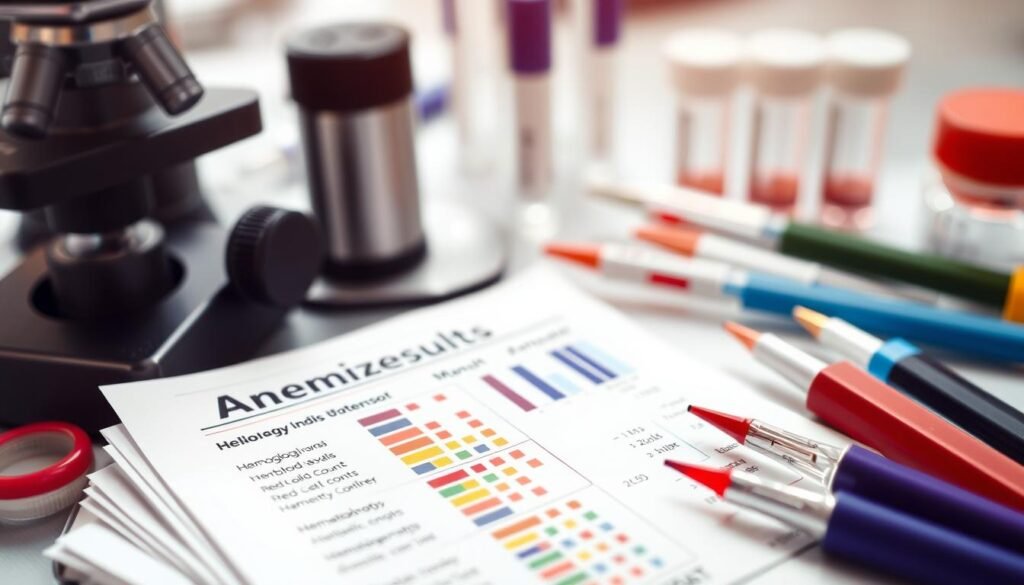Ever wondered why lacking red blood cells might mean needing a blood transfusion? Knowing all about Blood Transfusions for Anemia is key to manage it well. When anemia gets severe, choosing the right treatment is important.
The blood transfusion method is crucial for anemic patients whose health is at risk. This piece offers insights on anemia. You’ll learn about its symptoms, causes, and how treatment, including transfusions, helps. Understanding when transfusions are needed to regain health and energy is our goal.
Key Takeaways
- Blood transfusions are essential for treating severe anemia.
- Anemia is characterized by low red blood cell levels or quality.
- Understanding symptoms is vital for timely anemia treatment.
- Combined treatment options can improve overall health recovery.
- Severe symptoms may indicate the need for immediate intervention.
Understanding Anemia
Anemia is a significant health issue where there aren’t enough healthy red blood cells. These cells are crucial because they carry oxygen to your body’s tissues. When there’s a shortage, you might feel very tired or weak. Different factors can cause anemia, and it’s important to know about its types for proper treatment.
What is Anemia?
Anemia happens when there’s a decrease in red blood cells or hemoglobin in your body. This can be mild, affecting you little, or severe, causing major health problems. Nutritional deficiencies or chronic diseases are common causes. It’s important to recognize these causes to find the right treatment.
Common Types of Anemia
Some types of anemia occur more often:
- Iron-deficiency anemia: This form is due to not having enough iron, which is key for making hemoglobin.
- Vitamin-deficiency anemia: It happens when you’re missing important nutrients like vitamin B12 or folate, affecting red blood cell production.
- Aplastic anemia: A rare condition where the bone marrow can’t make sufficient blood cells, causing serious issues.
Knowing these common types helps in choosing the right treatment and shows why early diagnosis is crucial.
| Type of Anemia | Cause | Symptoms |
|---|---|---|
| Iron-deficiency anemia | Low iron intake or absorption | Fatigue, weakness, pale skin |
| Vitamin-deficiency anemia | Insufficient vitamin B12 or folate | Shortness of breath, dizziness |
| Aplastic anemia | Bone marrow dysfunction | Increased infections, excessive bleeding |
Symptoms of Anemia
Recognizing anemia symptoms early is crucial. The signs can vary, making awareness important. Common symptoms include:
- Fatigue
- Weakness
- Pale skin
- Dizziness
- Shortness of breath
Many people may not connect these anemia symptoms to anemia. This can delay getting the right treatment. Knowing these signs can help people get care sooner.

Recognizing the Signs
Being aware of symptoms is crucial for health monitoring. Fatigue might just seem like tiredness from a busy life. Pale skin may be thought to come from not enough sunlight. Knowing these signs is key to getting medical advice.
Impact of Symptoms on Daily Life
Anemia symptoms can greatly affect daily life. They can lower work productivity and stamina in physical activities. They can also lower one’s quality of life.
Knowing these symptoms can mean a serious condition is at hand. This leads to getting help and better health strategies. It shows why it’s important to know about anemia to handle challenges better.
For more details on these symptoms, check out this resource.
Causes of Anemia
Anemia can come from many things that make it hard for the body to make healthy red blood cells. Knowing the anemia causes helps in treating it right. Main causes are not getting enough nutrients, long-term diseases, and genes.
Nutritional Deficiencies
Not getting enough iron, vitamin B12, and folate can lead to anemia. A diet short on these nutrients might make fewer red blood cells. Iron deficiency is very common because of poor diet or not absorbing iron well. Eating well helps avoid these issues, showing why a good diet matters.
Chronic Diseases
Long-lasting diseases like kidney disease, cancer, and autoimmune disorders can make it hard to make red blood cells. These diseases mess with the body’s normal way of making blood, causing anemia. Knowing how these diseases connect to anemia is important. Treatment of the main disease can make anemia better and lessen other problems. Visit blood transfusions and their role for more info.
Genetic Factors
Genes also cause anemia, with diseases like sickle cell and thalassemia passed down through families. These diseases change how the body makes normal hemoglobin. This makes red blood cells work poorly. Genetic tests can find people who might get these types of anemia. This helps plan the best way to manage them.

Diagnosing Anemia
To identify anemia, doctors perform various tests. These help them figure out the cause and how severe the anemia is. With different tests, an accurate diagnosis can be made. This allows for a customized treatment approach.
Common Diagnostic Tests
A complete blood count (CBC) is a key first step. It checks hemoglobin levels and red blood cell count. Important for spotting anemia, this test starts the diagnosis path. Other tests might include:
- Iron studies to assess iron levels in the body.
- Vitamin B12 and folate tests, which determine the availability of essential vitamins for red blood cell production.
- Reticulocyte count, indicating how quickly the body is producing new red blood cells.
Interpreting Blood Test Results
Reading blood test results is crucial for a proper anemia diagnosis. Each test tells doctors something different:
| Test | Normal Range | Indication of Anemia |
|---|---|---|
| Hemoglobin Level (g/dL) | 13.5-17.5 (Men), 12.0-15.5 (Women) | Low levels suggest anemia. |
| Red Blood Cell Count (million cells/mcL) | 4.7-6.1 (Men), 4.2-5.4 (Women) | Low counts may indicate anemia. |
| Iron (mcg/dL) | 65-175 | Low levels can lead to iron-deficiency anemia. |
| Vitamin B12 (pg/mL) | 200-900 | Low levels might indicate pernicious anemia. |
| Folate (ng/mL) | 3.0-17.0 | Low folate levels can also contribute to anemia. |
Understanding blood test results helps doctors find the right treatment. In severe cases, this might include a blood transfusion.

Anemia Treatment Options
Anemia treatment varies because everyone is different. A key part of treating anemia is changing your diet. Adding certain foods can help raise your hemoglobin levels and your health.
Diet and Nutritional Adjustments
Eating a balanced diet is crucial for managing anemia. Foods that have a lot of iron are very important. You should try to eat:
- Red meat, poultry, and fish
- Beans, lentils, and tofu
- Dark leafy greens such as spinach and kale
- Fortified cereals and breads
- Nuts and seeds
Also, foods high in vitamin C can help your body take in more iron. Making these simple changes in what you eat can greatly improve how your body fights anemia.
Medication for Anemia
Sometimes, changing your diet isn’t enough. Doctors may give you medicine to help with anemia. Iron pills are often used when you don’t have enough iron. If you have trouble getting vitamin B12 from food, you might need injections. Drugs that help make more red blood cells are another choice. For more info on treating anemia, check out this source.
| Type of Anemia | Common Causes | Recommended Treatment |
|---|---|---|
| Iron Deficiency Anemia | Poor diet, blood loss | Iron supplements, dietary adjustments |
| Vitamin B12 Deficiency Anemia | Pernicious anemia, dietary insufficiency | Vitamin B12 injections, oral supplements |
| Aplastic Anemia | Bone marrow damage, autoimmune conditions | Medications, transfusions |
Knowing all the treatments for anemia lets you make the best choices for your health. Always talk to your doctor when planning how to treat your anemia.
Blood Transfusions for Anemia
Blood transfusions are key to getting healthy red blood cell levels back to normal. People who need it go through a well-planned process to keep them safe and comfortable. It involves getting donor blood through an IV at a medical place, under the close watch of healthcare pros.
What to Expect From a Blood Transfusion
The process has several steps to make sure everything goes well and safely. Here are the main parts:
- Pre-transfusion testing: They test to make sure the blood matches, to avoid bad reactions.
- IV insertion: A healthcare worker puts in an IV line for the blood to go through.
- Monitoring: They keep an eye on your vital signs the whole time.
- Post-transfusion care: Nurses check how you’re doing after.
Who Needs a Blood Transfusion?
Figuring out who needs blood for anemia is crucial for the right treatment. What they look at includes:
| Criteria | Description |
|---|---|
| Severity of Anemia | People with really low hemoglobin from bad anemia may urgently need this help. |
| Symptoms Presentation | If someone is really tired, breathing hard, or their heart is beating fast, they might need it. |
| Underlying Causes | Things like losing blood over time or issues with bone marrow can mean they need blood transfusions. |
When to Consider Blood Transfusions
Doctors think hard on when to give blood transfusions to those with anemia. Severe symptoms and serious issues mean they need to act fast. Spotting these signals early is key to helping well.
Severe Symptoms and Complications
Feeling very tired, dizzy all the time, and having trouble breathing are bad signs. Problems like heart failure can come from bad anemia. These problems may mean a blood transfusion is needed quickly.
Situations Requiring Immediate Action
For big blood loss from surgery, injuries, or stomach bleeds, transfusions help a lot. Knowing when these cases are urgent is crucial for doctors. Blood transfusions work fast to ease symptoms and fix blood levels, making them an important part of anemia care.
| Condition | Indications | Details |
|---|---|---|
| Severe Fatigue | Extremely low hemoglobin | Reduces daily functionality |
| Heart Failure | Increased heart strain | Potentially life-threatening |
| Significant Blood Loss | Trauma or surgery | Critical need for volume restoration |
Benefits of Blood Transfusions
Blood transfusions are key in managing low red blood cell counts. They offer quick relief for people with anemia. This leads to higher energy levels and better function once their hemoglobin is restored. Hence, patients can do more in their daily lives.
Quick Relief of Symptoms
After a blood transfusion, people recover faster from fatigue, weakness, and dizziness. These improvements can make life better for those with anemia. A quick rise in hemoglobin is especially important for those with severe anemia or who are having major medical procedures.
Supporting Overall Health Recovery
Blood transfusions help the overall recovery process, too. They ensure oxygen is carried well throughout the body. This helps keep vital organs working right. So, they play a big part in both short-term and long-term health for people with anemia.
Overall, blood transfusions improve patients’ health by dealing with immediate and long-term issues of anemia. They lead to better outcomes for patients by supporting full-body health.